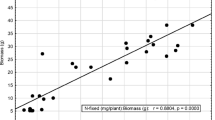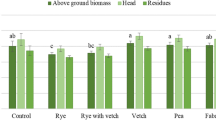Summary
The N-balance method was employed to estimate N2 fixation in a field-grown, early cultivar of cowpea (Vigna unguiculata L. Walp cv. ‘IT 82-18’) and groundnut (Arachis hypogaea L. cv. ‘Chinese’) using maize as reference plant. The maturity of all crops was well matched. Nitrogen derived from biological fixation was 101 kg ha−1 in groundnut and 201 kg ha−1 in cowpea, indicating that the two legumes could satisfy about 79% and 89%, respectively, of their N requirements from nodule symbiosis. Net N returns to soil in leguminous residues were 68 kg ha−1 for groundnut and 150 kg ha−1 for cowpea. Grain yields of maize succeeding maize and legumes during the same season showed marked differences (P<0.05) between maize-after-legumes, and maize-after-maize. Dry-matter yields were also significantly different (P<0.01) in a like manner. The application of five rates of N fertilizer, 0 to 120 kg (NH4)2SO4 ha−1, to maize indicated that at zero fertilizer-N, maize grain yields were 89% and 95% higher when grown after groundnut and cowpea than when preceded by maize, corresponding to 77% and 76% respectively of dry-matter yields. The N benefit of each legume to maize in the rotation was equivalent to 60 kg ha−1 of N fertilizer based on grain and dry-matter yields. About 27% and 60% of residue-N from cowpea and groundnut were utilised by the following maize crop, respectively. It was concluded that the proportions of N derived from decomposing leguminous residues by succeeding cereal crops during the first year of rotation are generally not high.
Résumé
La méthode du bilan d'azote a été employée pour estimer la fixation de l'azote par un cultivar initial de cowpea (Vigna unguiculata L. Walp cv. ‘IT 82-18’) et d'arachide (Arachis hypogaea L. cv. ‘Chinese’), le maïs servant de plante de référence. La maturité des différentes récoltes a été synchronisée. La quantité d'azote provenant de la fixation biologique a été de 101 kg ha−1 avec l'arachide et 201 kg ha−1 avec le cowpea, ce qui montre que les deux légumineuses peuvent, par fixation biologique, satisfaire environ 79 et 89% de leurs besoins en N. Le gain net du sol en N fourni par les résidus des légumineuses a été de 68 kg ha−1 dans le cas de l'arachide et 150 kg ha−1 dans celui du cowpea Le rendement en grain du maïs succédant au maïs et aux légumineuses au cours de la même saison présente des différences significatives (P<0,05) entre la succession légumineuses-maïs et maïs-maïs. Les rendements en matière sèche diffèrent eux aussi dans le même sens et de façon significative (P<0,01). L'application au maïs de cinq doses d'engreis azoté, allant de 0 à 120 kg ha−1, a montré qu'en l'absence d'engrais les rendements en grain du maïs sont 89% et 95% plus élevés après la culture d'arachide et de cowpea que dans le cas d'une succession maïs-maïs, et les rendements en matière sèche sont respectivement accrus de 77 et 76%. D'après les rendements en grain et en matière sèche, le gain net de N procuré au maïs par les deux légumineuses équivaut à 60 kh ha−1 d'engrais azoté. Environ 27% et 60% de l'azote résiduel provenant réspectivement du cowpea et de l'arachide sont utilisés par la culture secondaire de maïs. En conclusion, les proportions de l'azote fourni par la décomposition des résidus de légumineuses qui sont utilisées par une culture de céréales au cours de la première année de rotation sont peu élevées.
Resumen
El método del equilibrio nitrogenado se empleó para estimar la fijación de N2 en campo de un cultuvar temprano de caupí (Vigna unguiculata L. Walp cv. IT 82-18) y de uno de maní (Arachis hypogaea L. cv. chinese) utilizando el maíz como cultivo de referencia. La maduración de los tres cultivos fue simultanea. El nitrógeno derivado de la fijación biológica fue de 101 kg/ha en maní y de 201 kg/ha en caupí, indicando que ambas leguminosas podían satisfacer cerca de un 79% y de un 89%, respectivamente, de sus requerimientos en N2 mediante la simbiosis con nódulos. Los residuos de las leguminosas significaron un aporte neto de N al suelo de 68 kg/ha para el maní y de 105 kg/ha para el caupí. Las cosechas de maíz que sucedieron a los cultivos tempranos de leguminosas y de maíz mostraron unas marcadas diferencias significatives tanto en producción de grano (P<0.05) como en producción de materia seca (P<0.01). La aplicación de cinco niveles de fertilización nitrogenada (de 0 a 120 kg/ha en forma de (NH4), SO4) indicó que al nivel 0 la producción de maíz en grano fue, respectivamente, un 89% y un 95% superior cuando el cultivo se realizó después de maní y de caupí, comparándolo con el rendimiento obtenido cuando el cultivo precedente fue maíz, dichos valores corresponden a una producción en materia seca de respectivamente, 77% y 76%. El beneficio aportado por las leguminosas en la rotación con maíz fue equivalente a un abonado nitrogenado de 60 kg/ha, calculado sobre la producción de grano y de materia seca. Cerca de 27% y del 60% del residuo nitrogenado de caupí y de maní, respectivamente, fueron utilizados por la siguient cosecha de maíz. Se concluyó que las proporciones de N derivadas de la descomposición de residuos de leguminosas asimilables por la siguiente cosecha de cereales no son elevadas.
Similar content being viewed by others
References
Ahlawat, I.P.S., Singh, A. &Saraf, C.S. 1981 Effects of winter legumes on the N economy and productivity of succeeding cereals.Experimental Agriculture 17, 57–62.
Ahn, P.M. 1970West African Soils. London: Oxford University Press.
Birch, H.F. &Dougall, H.W. 1967 Effect of a legume on soil N mineralization and percentage N in grasses.Plant and Soil 27, 292–296.
Deibert, E.J., Bijeriego, M. &Olson, R.A. 1979 Utilization of15N fertilizer by nodulating and non-nodulating soybean isolines.Agronomy Journal 71, 717–723.
Fred, E.B., Baldwin, I.L. &McCoy, E. 1932Root Nodule Bacteria and Leguminous Plants. Madison: University of Wisconsin.
Gee, C.G. & Robinson, C.W. 1969 The economics of cropping sysems for Western Colorado.Bulletin 539S, Colorado Agricultural Experimental Station.
Herridge, D.F. 1982 Crop rotations involving legumes. InNitrogen Fixation in Legumes, ed. Vincent, J.M. pp. 253–261. Sydney: Academic Press.
Hesterman, O.B., Sheaffer, C.C., Barnes, D.K., Lueschen, W.E. &Ford, J.H. 1986a Alfalfa dry matter and N production, and fertilizer N response in legume-corn rotations.Agronomy Journal 78, 19–23.
Hesterman, O.B., Sheaffer, C.C. &Fuller, E.I. 1986b Economic comparisons of crop rotations including alfalfa, soybean and corn.Agronomy Journal 78, 24–28.
Jones, M.J. 1973 The organic matter content of the savanna soils of West Africa.Journal of Soil Science 24, 42–53.
Juo, A.S.R. &Lal, R. 1977 The effect of fallow and continuous cultivation on the chemical and physical properties of an alfisol in Western Nigeria.Plant and Soil 47, 567–584.
Kohl, D.H., Shearer, G. &Harper, J.E. 1980 Estimates of N2 fixation based on differences in the natural abundance of15N in nodulating and non-nodulating isolines of soybean.Plant Physiology 66, 61–65.
Ladd, J.N. 1981 The use of15N in following organic matter turnover with specific reference to rotation systems.Plant and Soil 58, 401–411.
Ladd, J.N., Amato, M., Jackson, R.B. &Butler, J.H.A. 1983 Utilization by wheat crops of N from legume residues decomposing in soils in the field.Soil Biology and Biochemistry 15, 231–238.
Ladd, J.N., Oades, J.M. &Amato, M. 1984 Distribution and recovery of N from legume residues decomposing in soils sown to wheat in the field.Soil Biology and Biochemistry 13, 251–256.
Mathan, K.K., Sankaran, K., Kanakabushani, N. &Krishnamoorthy, K.K. 1979 Redistribution of N in an ecosystem due to long-term fertilization and continuous cropping.Plant and Soil 51, 593–596.
Naes, 1985 Nyankpala Agricultural Experiment Station Annual Report 1984/1985, Nyankpala, Tamale, Ghana.
Nye, P.H. &Greenland, D.J. 1960 The soil under shifting cultivation,Technical Communication 51. Harpenden: Commonwealth Bureau of Soils.
Reddy, K.C., Soffes, A.R. &Prine, G.M. 1986 Tropical legumes for green manure. I. N production and the effects on succeeding crop yields.Agronomy Journal 78, 1–4.
Rennie, R.J. 1984 Comparison of N balance and15N isotope dilution toquantify N2 fixation in field-grown legumes.Agronomy Journal 76,785–790.
Rennie, R.J. &Rennie, D.A. 1983 Techniques for quantifying N2 fixation in association with non-legumes under field and glasshouse conditions.Canadian Journal of Microbiology 29, 1022–1035.
Ruschel, A.P., Vose, P.B., Victoria, R.L. &Salati, E. 1979 Comparison of isotopes techniques and non-nodulating isolines to study the effect of ammonium fertilization on dinitrogen fixation in soybean (Glycine max).Plant and Soil 53, 513–525.
Suwanarit, A., Suwannarat, C. &Chotechaungmanirat, S. 1986 Quantities of fixed N and effects of grain legumes on following maize, and N and P status of soil as indicated by isotopes.Plant and Soil 93, 249–258.
Vasilas, B.L. &Ham, G.E. 1984 Nitrogen fixation in soybeans: An evaluation of measurement techniques.Agronomy Journal 76, 759–764.
Vine, H. 1953 Experiments on the maintenance of soil fertility at Ibadan, Nigeria.Empire Journal of Experimental Agriculture 21, 65–85.
Wetselaar, R. 1967 Estimation of N2 fixation by four legumes in dry monsoonal area of northwestern Australia.Australian Journal of Experimental Agriculture and Animal Husbandry 7, 518–522.
Yaacob, O. &Blair, G.J. 1979 Effect of legume species and cropping intensity on the N status of a granite soil under a stimulated tropical environment.Plant and Soil 52, 85–97.
Author information
Authors and Affiliations
Rights and permissions
About this article
Cite this article
Dakora, F.D., Aboyinga, R.A., Mahama, Y. et al. Assessment of N2 fixation in groundnut (Arachis hypogaea L.) and cowpea (Vigna unguiculata L. Walp) and their relative N contribution to a succeeding maize crop in Northern Ghana. Mircen Journal 3, 389–399 (1987). https://doi.org/10.1007/BF00935697
Received:
Accepted:
Issue Date:
DOI: https://doi.org/10.1007/BF00935697




